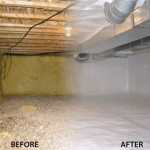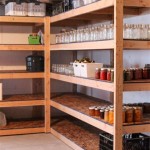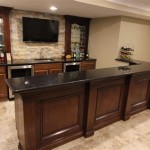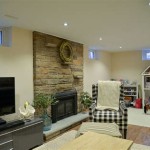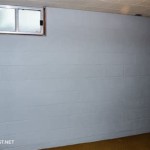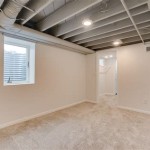What Is The Best Floor Covering For A Concrete Basement Wall?
Selecting the optimal floor covering for a concrete basement wall requires careful consideration of several factors, primarily related to moisture management, insulation, and aesthetics. Concrete basement walls are inherently prone to moisture intrusion from the surrounding soil, which can lead to a variety of problems, including mold growth, structural damage, and an uncomfortable living environment. Therefore, the chosen floor covering must be able to withstand moisture, promote proper ventilation, and ideally, provide some level of thermal insulation.
It is crucial to differentiate between floor coverings installed directly *on* the concrete slab floor and those applied *to* the concrete basement walls. This article focuses specifically on floor coverings applied to the concrete *walls* of a basement. While some of the principles regarding moisture management are similar for both floors and walls, certain materials and installation techniques are more suitable for vertical surfaces.
Before embarking on any wall covering project in a basement, a thorough assessment of the existing conditions is paramount. This includes identifying the source and extent of any moisture problems, inspecting for cracks or structural issues in the concrete, and determining the desired aesthetic outcome. Addressing moisture issues is non-negotiable; simply covering up a damp wall will inevitably lead to more significant and expensive problems down the line. This may involve improving exterior drainage, sealing cracks, or installing a dehumidifier.
Key Considerations for Basement Wall Coverings
Several key factors should influence the selection of a floor covering for concrete basement walls. These encompass moisture resistance, ease of installation, cost effectiveness, aesthetic appeal, and durability. Balancing these factors will lead to a suitable and long-lasting solution.
* Moisture Resistance and Breathability: This is arguably the most critical factor. The chosen material should either be impervious to water or allow moisture vapor to pass through without degrading. Breathable materials permit the concrete to "breathe," allowing trapped moisture to evaporate rather than accumulating behind the wall covering, which prevents mold growth. * Ease of Installation: The complexity of installation can significantly impact both the cost and the time required to complete the project. Some materials necessitate professional installation, while others are suitable for DIY projects. Consider your skill level and budget when evaluating installation requirements. * Cost Effectiveness: The cost of materials and installation can vary widely depending on the chosen floor covering. It is essential to establish a budget and compare the upfront costs of different options, as well as their long-term maintenance requirements.Popular Options for Concrete Basement Wall Coverings
A variety of materials are commonly used for covering concrete basement walls, each with its own set of advantages and disadvantages. Understanding the properties of these materials is crucial for making an informed decision.
* Concrete Waterproofing Paint/Sealant: This is a common and relatively inexpensive option. These products are designed to create a waterproof barrier on the concrete surface, preventing moisture from seeping through. It's important to choose a product specifically formulated for concrete basement walls and to apply it according to the manufacturer's instructions. Multiple coats are usually required for optimal protection. While offering moisture protection, some paints might not allow the wall to breathe and could lead to trapped moisture. * Epoxy Coatings: Epoxy coatings provide a durable and waterproof finish that is resistant to chemicals and abrasion. They are available in a variety of colors and finishes, making them a versatile option for achieving different aesthetic looks. However, epoxy coatings can be relatively expensive and require professional installation. Like some waterproofing paints, some formulas might not be breathable. * Rigid Foam Insulation Panels: Rigid foam insulation, such as extruded polystyrene (XPS) or expanded polystyrene (EPS), can be installed directly onto the concrete walls to provide thermal insulation and reduce condensation. These panels are typically attached with adhesive and can be covered with drywall or another finishing material. These panels help to moderate temperature swings, making the basement more comfortable. Importantly, they also act as a vapor barrier, preventing moisture from reaching the concrete. * Moisture-Resistant Drywall: Drywall specifically designed for moisture-prone environments, such as green board or blue board, can be installed over a stud wall frame built against the concrete. This provides a smooth, paintable surface and allows for the inclusion of insulation within the stud cavities. This option introduces a cavity between the concrete wall and the drywall, and it is imperative to take precautions against moisture build-up in this cavity. Properly installed vapor barriers, as well as the use of breathable insulation, are critical. * Waterproof Wall Panels: Various interlocking wall panels are designed specifically for basement applications. These panels are typically made of PVC or other waterproof materials and require minimal preparation. They are simple to install, easy to clean, and resistant to mold and mildew. These panels often provide a finished look, eliminating the need for additional painting or finishing. * Tile (Porcelain or Ceramic): Tile, particularly porcelain or ceramic, is highly resistant to moisture and can create a durable and attractive wall finish. It is suitable for spaces where water exposure is likely, such as bathrooms or laundry rooms. However, tile installation can be complex and requires specialized tools and skills. Also, tiling requires the concrete wall to be very flat and level, which might require surface preparation. * Wood Paneling: While wood is generally not recommended due to its susceptibility to moisture damage, certain types of treated wood paneling can be used in basements if proper precautions are taken. This includes ensuring adequate ventilation and using a moisture barrier between the wood and the concrete wall. However, even with these precautions, wood paneling remains a riskier option compared to other materials. * Basement Wall Membrane Systems: These are specialized systems designed to provide a complete moisture management solution for basement walls. They typically consist of a dimpled membrane that creates an air gap between the concrete and the finished wall surface, allowing moisture to drain down to a perimeter drainage system. This type of system is often used in conjunction with insulation and drywall to create a comfortable and dry basement environment.Addressing Moisture and Ventilation
Regardless of the chosen floor covering, addressing moisture and ensuring adequate ventilation are essential for maintaining a healthy and comfortable basement environment. Proper drainage around the foundation, sealing cracks in the concrete, and running a dehumidifier are all important steps in preventing moisture problems. Ventilation helps to circulate air and reduce humidity levels, further minimizing the risk of mold growth.
The installation of a vapor barrier is a crucial element in many basement wall finishing projects. The vapor barrier's purpose is to impede the movement of water vapor through the wall assembly, preventing it from reaching the colder surface where it can condense and potentially lead to mold and mildew growth. It's critical, therefore, that the vapor barrier is properly installed, with all seams tightly sealed to prevent vapor penetration.
The specific type of vapor barrier that is appropriate depends on the climate. In colder climates, the vapor barrier should typically be installed on the warm side of the wall, which is the interior side, closest to the conditioned space. In warmer, more humid climates, the placement of the vapor barrier can be more complex and might even be omitted in some cases, as it could potentially trap moisture within the wall cavity.
Beyond physical barriers and materials, actively managing humidity within the basement is crucial. Dehumidifiers are particularly effective at removing excess moisture from the air, reducing the overall humidity level. It is also wise to ensure that ventilation throughout the basement is adequate. Regular airflow helps to prevent stagnant, moist air from accumulating, which can further deter mold and mildew growth. A combination of natural ventilation, if possible, and mechanical ventilation systems can be used to achieve this goal.
DIY vs. Professional Installation
The decision of whether to tackle the basement wall covering project as a DIY endeavor or to hire a professional contractor is contingent upon several variables, encompassing the complexity of the chosen material, the homeowner's skill set, and the available budget. Some materials, such as concrete waterproofing paint or interlocking wall panels, are relatively straightforward to install and can be successfully completed by a motivated homeowner. Others, such as epoxy coatings or tile installations, require specialized tools, expertise, and a high degree of precision, making professional installation the more prudent choice.
Employing a qualified contractor offers several advantages. Professionals possess the knowledge and experience to properly assess the existing conditions, identify potential problems, and recommend the most suitable solution. They also have access to specialized tools and equipment, ensuring that the installation is completed correctly and efficiently. Moreover, many contractors offer warranties on their work, providing peace of mind and protection against potential defects. However, professional installation comes at a higher cost, which may be a significant consideration for homeowners on a tight budget.
Homeowners contemplating a DIY project should carefully evaluate their skills and limitations. It is essential to thoroughly research the installation process, gather the necessary tools and materials, and follow the manufacturer's instructions precisely. Taking shortcuts or neglecting proper preparation can lead to subpar results and potentially costly repairs down the line. If in doubt, it is always advisable to consult with a professional before proceeding.
Long-Term Maintenance
Regardless of the chosen floor covering, regular maintenance is crucial for preserving its appearance and preventing moisture problems. This includes inspecting the walls periodically for signs of water damage, such as discoloration, staining, or mold growth. Any leaks or cracks should be addressed promptly to prevent further damage.
Cleaning the wall surfaces regularly with a mild detergent and water will help to remove dirt and grime, preventing the buildup of mold and mildew. Avoid using harsh chemicals or abrasive cleaners, as these can damage the floor covering. For surfaces that are prone to mold growth, a solution of bleach and water can be used to disinfect the area.
The lifespan of the floor covering will depend on the material used and the level of maintenance provided. Concrete waterproofing paint and sealants may need to be reapplied every few years, while more durable materials, such as epoxy coatings or tile, can last for decades with proper care.

The Best Floors To Have Installed Onto Concrete Empire Today Blog

Thermaldry Basement Flooring Systems Waterproof

Best Basement Flooring The Warmest Floor Covering Is Cork

What Is The Best Flooring For A Concrete Floor Basement Illinado Llc

2024 Buyer S Guide Best Basement Flooring Over Concrete

Best Basement Flooring Ideas Options Over Concrete

Best Basement Flooring Options Costs And Ideas 2024 Hgtv
The Best Flooring Options For Your Basement America

Best Flooring Options For Your Basement Ideas Floor

A Guide To Stained Concrete Basement Floors
Related Posts


